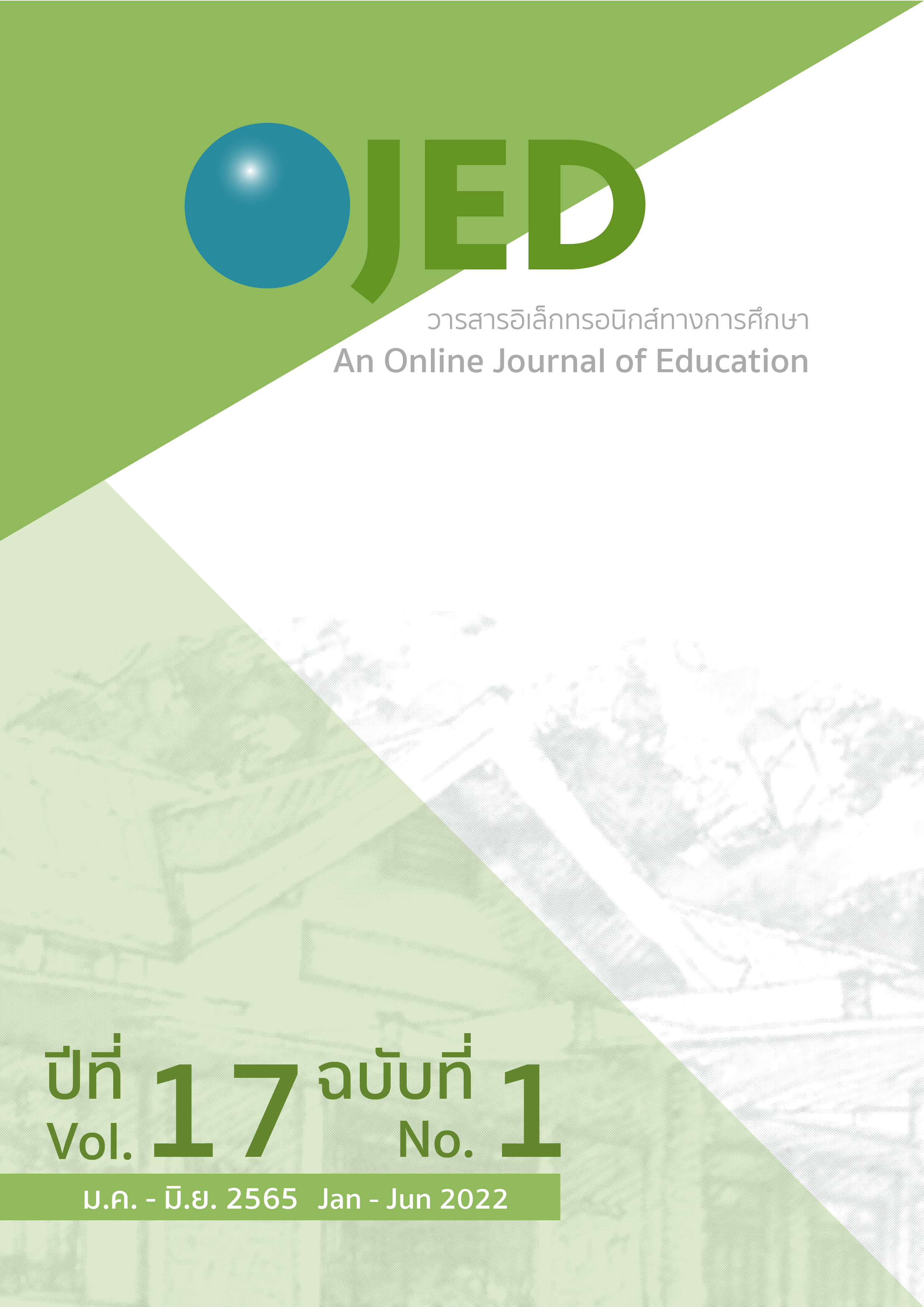Validation of Situation Awareness Test for Nurse Anesthetist Students Using Confirmatory Factor Analysis
DOI:
https://doi.org/10.14456/ojed.2022.20Keywords:
confirmatory factor analysis, situation awareness scale of nurse anesthetist students, validationAbstract
This study aimed at validating situation awareness test using confirmatory factor analysis (CFA). The participants were 136 nurse anesthetist students from multistage sampling. The research instrument was situation awareness scale 48 items developed from Endsley’s situation awareness concept with content validity ranging from .57 to .86 and internal consistency reliability was .75. The collected data were analyzed with confirmatory factor analysis for construct validation. The results were as follows: the confirmatory factor analysis of situation awareness model had 3 factors namely perception, understand and projection. The perception factor consisted of 2 indicators collect and inspect. The factor loadings were .45 and .66 respectively. The understand factor consisted of 2 indicators interpret and conclusion. The factor loadings were .61 and .65 respectively. The projection factor consisted of 2 indicators practice and event. The factor loadings were .74 and .99 respectively. The validation of goodness of fitted model yielded a Chi-square of 3.84, p=.57 at a degree of freedom of 5 (GFI=0.991, AGFI=0.961 and RMSEA= 0.000). The situation awareness scale of nurse anesthetist students has construct validity.
References
โครงการฝึกอบรมวิสัญญีพยาบาล ภาควิชาวิสัญญีวิทยา. (2562). รายงานผลการสอบภาคปฏิบัตินักศึกษา วิสัญญีพยาบาลรุ่นที่ 50 [เอกสารรายงานผลการสอบภาคปฏิบัตินักศึกษาวิสัญญีพยาบาลรุ่นที่ 50]. คณะแพทยศาสตร์ศิริราชพยาบาล, มหาวิทยาลัยมหิดล.
ศิริชัย กาญจนวาสี. (2556). ทฤษฎีการทดสอบแบบดั้งเดิม (พิมพ์ครั้งที่ 7). โรงพิมพ์แห่งจุฬาลงกรณ์มหาวิทยาลัย.
Anderson, J. C., & Gerbing, D. W. (1988). Structural equation modeling in practice: A review and recommended two-step approach. Psychological bulletin, 103(3), 411.
Ding, L., Velicer, W. F., & Harlow, L. L. (1995). Effects of estimation methods, number of indicators per factor, and improper solutions on structural equation modeling fit indices. Structural Equation Modeling: A Multidisciplinary Journal, 2(2), 119-143.
Endsley, M. R. (1995a). Measurement of situation awareness in dynamic systems. Human factors, 37(1), 65-84.
Endsley, M. R. (1995b). Toward a theory of situation awareness in dynamic systems. Human factors, 37(1), 32-64.
Endsley, M. R. (2015). Situation awareness misconceptions and misunderstandings. Journal of cognitive engineering and decision making, 9(1), 4-32.
Endsley, M. R. (2021). A systematic review and meta-analysis of direct objective measures of situation awareness: a comparison of SAGAT and SPAM. Human factors, 63(1), 124-150.
Hair, J. F., Black, W. C., Babin, B. J., & Anderson, R. E. (2010). Confirmatory factor analysis. Multivariate Data Analysis, 7th ed.; Pearson Education, Inc.: Upper Saddle River, NJ, USA, 600-638.
Hox, J. J. (2010). Multilevel analysis: techniques and applications (2nd ed.) Routledge. [Google Scholar].
Hultin, M., Jonsson, K., Härgestam, M., Lindkvist, M., & Brulin, C. (2019). Reliability of instruments that measure situation awareness, team performance and task performance in a simulation setting with medical students. BMJ open, 9(9), e029412.
Sætrevik, B., & Hystad, S. W. (2017). Situation awareness as a determinant for unsafe actions and subjective risk assessment on offshore attendant vessels. Safety science, 93, 214-221.
Steiger, J. H. (2007). Understanding the limitations of global fit assessment in structural equation modeling. Personality and Individual Differences, 42, 893-898.
Tabachnick, B. G., & Fidell, L. S. (2007). Using multivariate statistics Boston. Allyn and Bacon, 5, 2007.
Taylor, R. M. (2017). Situational awareness rating technique (SART): The development of a tool for aircrew systems design. In Situational awareness (pp. 111-128). Routledge.
Tinsley, H. E., & Tinsley, D. J. (1987). Uses of factor analysis in counseling psychology research. Journal of counseling psychology, 34(4), 414.
Tomlinson, J. (2018). Obstetric GA’s. Am I doing it right?. UKZN dept of Anaesthesiology and Critical Care, 11.
Wright, S. M. (2015). Patient safety in anesthesia: learning from the culture of high-reliability organizations. Critical Care Nursing Clinics, 27(1), 1-16.
Downloads
Published
How to Cite
Issue
Section
License
Copyright (c) 2022 An Online Journal of Education

This work is licensed under a Creative Commons Attribution-NonCommercial-NoDerivatives 4.0 International License.




